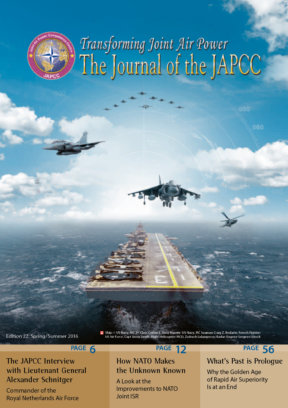Editorial
It is my great pleasure to present you the 22nd Edition of the JAPCC Journal. The opening article of this edition is an interview with The Netherlands’ Air Chief Lieutenant General Schnitger, who offers us his perspective on future airpower requirements and how the RNLAF shall be kept ‘Fit for the Future’ by a program called the ‘Air Force 3.0’. We greatly appreciate his senior leader’s perspective. In this editorial, I’ll depart from my tradition of discussing upcoming articles to talk about a couple of things that are significant to Joint Air and Space Power in NATO today, Anti-Access / Area Denial (A2AD) and the Joint Air Power Strategy.
NATO Joint Air Power today is abuzz with talk of ‘A2AD’, which is a relatively new term describing a relatively old problem. A2AD is simply the ability to prevent opposing forces from entering an area and, if they are there, restricting their freedom of movement. As NATO has been focussing on operations outside of the European area of responsibility, our adversaries here and across the globe have been watching carefully, designing systems that are dedicated to prevent us from operating our military assets to their full potential should a conflict of interests materialize. On the one hand, it sounds like ‘old wine in new bags’, however, what’s worthwhile noting is that the ‘new’ A2AD refers to an aggressively designed combination of cyber, electronic warfare, and highly capable integrated air defence systems woven together in a flexible and mobile fashion to create areas which are effectively impenetrable. How to effectively conduct operations in these contested or non-permissive A2AD environments is something to which NATO must turn its attention.
Recently, the North Atlantic Council tasked the NATO Military Authorities (NMAs) to draft a Joint Air Power Strategy for the Alliance. This strategy will first develop a conceptual basis for air power and then address the development of long-term air power capabilities. This work will be a continuation of the work started by the NMAs in their military advice to the Council, which was submitted to the Military Committee in late 2016. The JAPCC was honoured to be a part of the team that developed that advice, which recommended the development of the strategy, and we are honoured to have again been invited to participate in the drafting team.
Thank you for taking the time to read this edition of our Journal. I congratulate the authors on their contributions to this 22nd JAPCC Journal and I strongly encourage our readers to consider sharing your thoughts as you go forth and advocate for Air Power. The JAPCC team greatly appreciates your feedback and thoughts. Please visit our website at www.japcc.org, like us on Facebook, or follow us on Twitter and LinkedIn to tell us what you think.
Madelein Spit
Air Commodore, NE AF
Assistant Director








